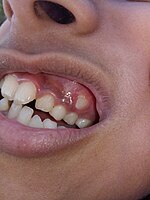
Photo from wikipedia
Objective. To evaluate the difference between chronological and dental age, calculated by Willems and Cameriere methods, in various skeletal patterns according to Steiner's ANB Classification. Methods. This retrospective cross-sectional study… Click to show full abstract
Objective. To evaluate the difference between chronological and dental age, calculated by Willems and Cameriere methods, in various skeletal patterns according to Steiner's ANB Classification. Methods. This retrospective cross-sectional study comprised the sample of 776 participants aged between 7 and 15 years (368 males and 408 females). For each participant, panoramic images (OPT) and laterolateral cephalograms (LC) were collected from the medical database. On LC ANB angle was measured; on OPT dental age (DA) was calculated while chronological age (CA) and sex were recorded. The sample was divided into three subgroups (Class I, Class II, and Class III) with similar distribution based on the chronological age and ANB angle. CA was calculated as the difference between the date of OPT imaging and the date of birth, while DA was evaluated using Willems and Cameriere methods. ANB angle was measured on LC by two independent investigators using the cephalometric software. Differences between sexes and the difference between dental and chronological age were tested by independent and paired samples t-test, respectively; one-way ANOVA was used to test differences among ANB classes with Tukey post hoc test to compare specific pairs of ANB classes. Results. The significant difference was found between Class III and other two skeletal classes in males using both dental age estimation methods. In Class III males dental age was ahead averagely by 0.41 years when using Willems method, while Cameriere method overestimated CA for 0.22 years. Conclusion. In males with Class III skeletal pattern, dental development is faster than in Classes I and II skeletal pattern. This faster development is not present in females.
Journal Title: BioMed Research International
Year Published: 2017
Link to full text (if available)
Share on Social Media: Sign Up to like & get
recommendations!